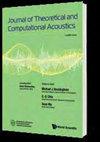复杂运动声源的切割有限元建模方法
IF 1
3区 物理与天体物理
Q3 ACOUSTICS
Journal of Theoretical and Computational Acoustics
Pub Date : 2023-10-21
DOI:10.1142/s2591728523500184
引用次数: 0
摘要
虽然用有限元方法进行声学分析通常是在假设声源位置固定的情况下进行的,但这并不总是一个有效的假设。本文导出了一种使用非拟合网格方法来模拟移动声源的方法,其中声源边界通过切割单元来描述,称为切割有限元法(cutFEM)。通过使用这种方法,网格在模拟过程中保持静态,即使对于大的源运动,从而避免昂贵的重新网格划分或网格变形步骤。为了能够描述各种各样的声源,考虑了大厚度和薄厚度的声源。评估了几种时间积分方案,并推导了确定时变方程组稳定性的方法。最后用两个算例对所导出的方法进行了验证,结果表明非拟合网格法是一种可行的模拟运动源的方法。本文章由计算机程序翻译,如有差异,请以英文原文为准。
Modeling of complex moving sound sources using a cut finite element method approach
While acoustic analysis with the finite element method is commonly done under the assumption that the source location is stationary, this is not always a valid assumption. This paper derives a method to simulate moving sound sources using an unfitted mesh approach, where the source boundary is described by cutting through elements, known as the cut finite element method (cutFEM). By using such an approach the mesh stays static during simulation, even for large source movements, thus avoiding expensive re-meshing or mesh morphing steps. To be able to describe a wide variety of acoustic sources, both sources with a large and thin thickness are considered. Several time integration schemes are assessed and a method to determine the stability of the resulting time-varying system of equations is derived. The paper concludes by demonstrating the derived methods with two examples, where it is shown that the unfitted mesh approach is a viable way to simulate moving sources.
求助全文
通过发布文献求助,成功后即可免费获取论文全文。
去求助
来源期刊

Journal of Theoretical and Computational Acoustics
Computer Science-Computer Science Applications
CiteScore
2.90
自引率
42.10%
发文量
26
期刊介绍:
The aim of this journal is to provide an international forum for the dissemination of the state-of-the-art information in the field of Computational Acoustics.
Topics covered by this journal include research and tutorial contributions in OCEAN ACOUSTICS (a subject of active research in relation with sonar detection and the design of noiseless ships), SEISMO-ACOUSTICS (of concern to earthquake science and engineering, and also to those doing underground prospection like searching for petroleum), AEROACOUSTICS (which includes the analysis of noise created by aircraft), COMPUTATIONAL METHODS, and SUPERCOMPUTING. In addition to the traditional issues and problems in computational methods, the journal also considers theoretical research acoustics papers which lead to large-scale scientific computations.
 求助内容:
求助内容: 应助结果提醒方式:
应助结果提醒方式:


